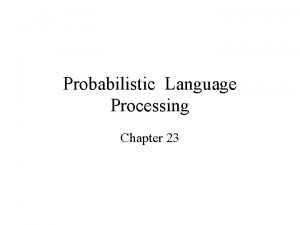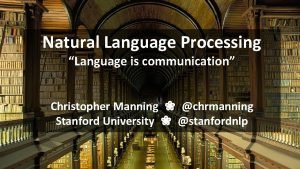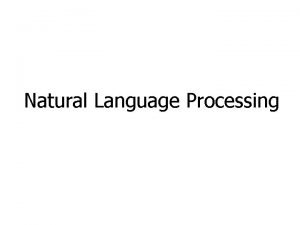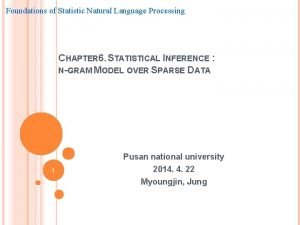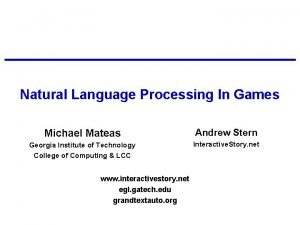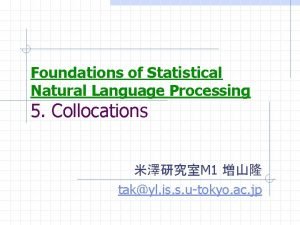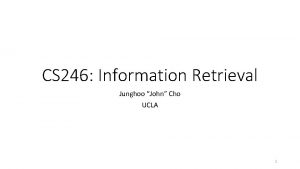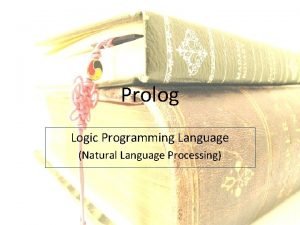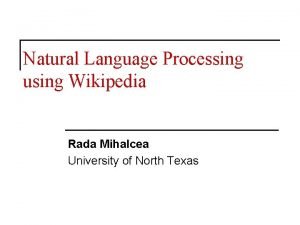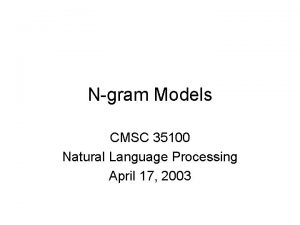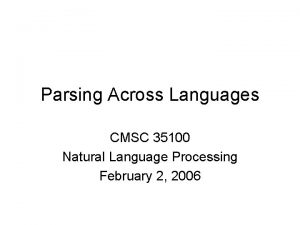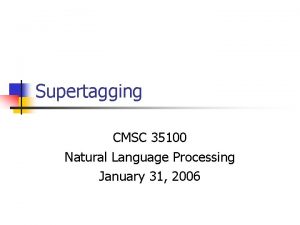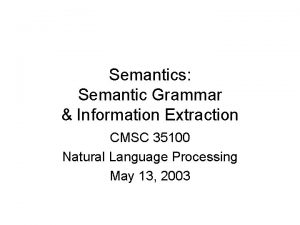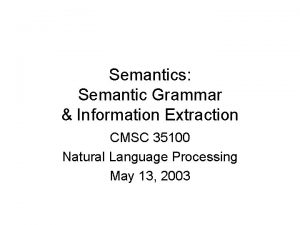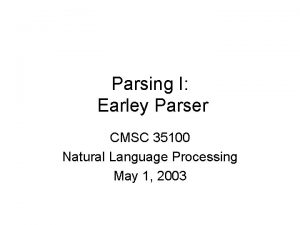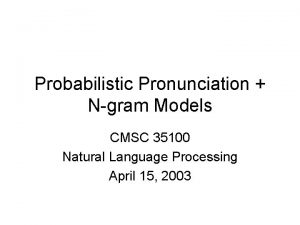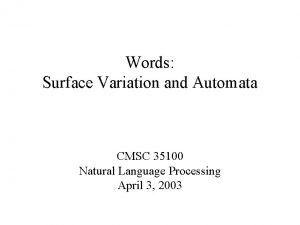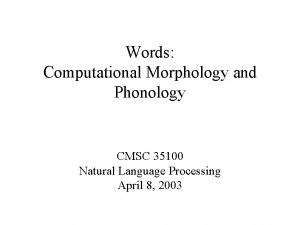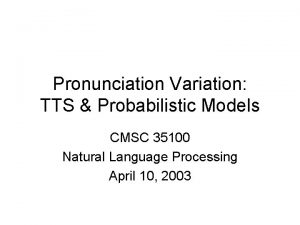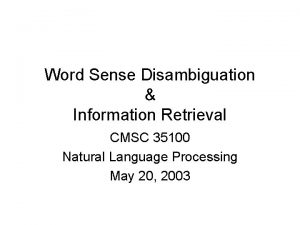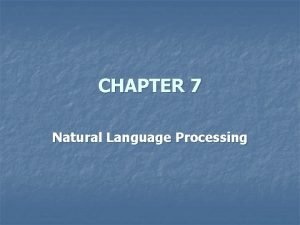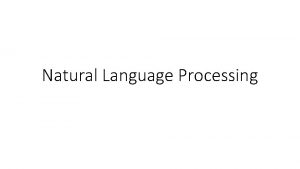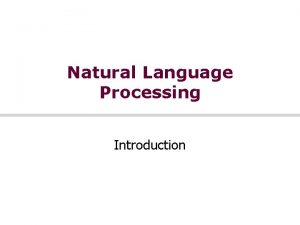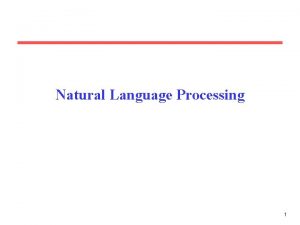Semantic Analysis CMSC 35100 Natural Language Processing May
















- Slides: 16

Semantic Analysis CMSC 35100 Natural Language Processing May 8, 2003

Roadmap • Semantic Analysis – Motivation: • Understanding commands – Approach I: Syntax-driven semantic analysis • Augment productions with semantic component – Lambda calculus formulation – Approach II: Semantic Grammar • Augment with domain-specific semantics – Approach III: Information Extraction • Template-based semantics

Understanding Commands • “What do I have on Thursday? ” • Parse: S Q-Wh-obj Whwd Aux NP Pron VP/NP V NP/NP Temporal P NP N What do I have t on Thursday

Understanding Commands • Parser: – Yes, it’s a sentence & here’s the structure • System: Great! But what do I do? S Q-Wh-obj Whwd What Action: Check calendar Cal Owner: User Date: Thursday Cal NP VP/NP Date: Thursday Aux Owner: User Pron V NP/NP Temporal Date: Thursday Cal P NP Date: Thursday Owner: User N Date: Thursday do I have t on Thursday

Syntax-driven Semantic Analysis • Key: Principle of Compositionality – Meaning of sentence from meanings of parts • E. g. groupings and relations from syntax • Question: Integration? • Solution 1: Pipeline – Feed parse tree and sentence to semantic unit – Sub-Q: Ambiguity: • Approach: Keep all analyses, later stages will select

Simple Example • Ay. Caramba serves meat. S NP Prop-N VP V NP N Ay. Caramba serves meat.

Rule-to-Rule • Issue: – Need detailed information about sentence, parse tree • Infinitely many sentences & parse trees • Solution: – Tie semantics to finite components of grammar • E. g. rules & lexicon – Augment grammar rules with semantic info • Aka “attachments” – Specify how RHS elements compose to LHS

Semantic Attachments • Basic structure: – A-> a 1…. an {f(aj. sem, …ak. sem)} • Language for semantic attachments – Lambda calculus • Extends First Order Predicate Calculus (FOPC) with function application • Example (continued): – Nouns represented by constants • Prop-n -> Ay. Caramba {Ay. Caramba} • N -> meat {meat}

Semantic Attachment Example • Phrase semantics is function of SA of children – E. g. NP -> Prop-n – NP -> N {Prop-n. sem} {N. sem} • More complex functions are parameterized – E. g. Verb -> serves – VP -> Verb NP • Application= – S -> NP VP • Application= {V. sem(NP. sem)}

Complex Attachments • Complex terms: – Allow FOPC expressions to appear in otherwise illegal positions • E. g. Server(e, x Isa(x, Restaurant)) • Embed in angle brackets • Translates as x Isa(x, Restaurant) Server(e, x) – Connective depends on quantifier • Quantifier Scoping – Ambiguity: Every restaurant has a menu • Readings: all have a menu; all have same menu • Potentially O(n!) scopings (n=# quanifiers) – Solve ad-hoc fashion

Inventory of Attachments • • S -> NP VP S -> Aux NP VP S -> Wh. Word NP VP {DCL(VP. sem(NP. sem))} {IMP(VP. sem(Dummy. You)} {YNQ(VP. sem(NP. sem))} – {WHQ(NP. sem. var, VP. sem(NP. sem))} • • • Nom -> Noun Nom {λx Nom. sem(x) NN(Noun. sem)} PP -> P NP {P. sem(NP. sem)} ; ; NP mod PP -> P NP {NP. sem} ; ; V arg PP P -> on {λyλx On(x, y)} Det -> a { } Nom -> N {λx Isa(x, N. sem)}

Earley Parsing with Semantics • Implement semantic analysis – In parallel with syntactic parsing • Enabled by compositional approach • Required modifications – Augment grammar rules with semantic field – Augment chart states with meaning expression – Completer computes semantics – e. g. unifies • Can also fail to unify – Blocks semantically invalid parses • Can impose extra work

Sidelight: Idioms • Not purely compositional – E. g. kick the bucket = die – tip of the iceberg = beginning • Handling: – Mix lexical items with constituents (word nps) – Create idiom-specific const. for productivity – Allow non-compositional semantic attachments • Extremely complex: e. g. metaphor

Approach II: Semantic Grammars • Issue: – Grammatical overkill • Constituents with little (no) contribution to meaning • Constituents so general that semantics are vacuous – Mismatch of locality • Components scattered around tree • Solution: Semantic Grammars – Developed for dialogue systems • Tied to domain • Exclude unnecessary elements

Semantic Grammar Example • What do I have on Thursday? – Cal. Q -> What Aux User. P have {on} Date. P • Cal action: =find; Cal. Owner: = head User. P; Date: =head Date. P; – User. P-> Pron • Head: =Head Pron – Pron-> I • Head: = USER – Date. P -> Dayof Week • Head: = sem Dayof. Week

Semantic Grammar Pros & Cons • Useful with ellipsis & anaphora – Restrict input by semantic class: e. g. Data. P • Issues: – Limited reuse • Tied to application domain – Simple rules may overgenerate
 Natural language processing vietnamese
Natural language processing vietnamese Probabilistic model natural language processing
Probabilistic model natural language processing Natural language processing
Natural language processing Markov chain nlp
Markov chain nlp Manning natural language processing
Manning natural language processing Grammar adalah
Grammar adalah Discourse analysis nlp
Discourse analysis nlp Nlp lecture notes
Nlp lecture notes Language
Language Natural language processing fields
Natural language processing fields Statistical natural language processing
Statistical natural language processing Natural language processing lecture notes
Natural language processing lecture notes Natural language processing games
Natural language processing games Foundation collocation
Foundation collocation Ucla natural language processing
Ucla natural language processing History of prolog
History of prolog Rada mihalcea
Rada mihalcea

